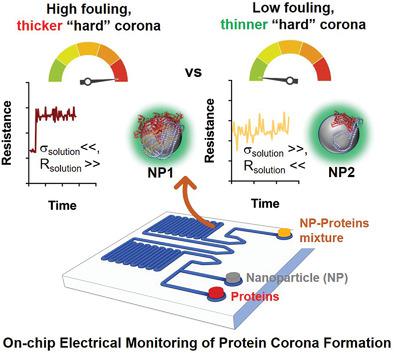当前位置:
X-MOL 学术
›
Small Methods
›
论文详情
Our official English website, www.x-mol.net, welcomes your feedback! (Note: you will need to create a separate account there.)
On‐Chip Electrical Monitoring of Real‐Time “Soft” and “Hard” Protein Corona Formation on Carbon Nanoparticles
Small Methods ( IF 12.4 ) Pub Date : 2020-04-20 , DOI: 10.1002/smtd.202000099 Indrajit Srivastava 1, 2 , Muhammad S. Khan 1, 2 , Ketan Dighe 1, 2 , Maha Alafeef 1, 2, 3 , Zhen Wang 1, 2 , Tuseeta Banerjee 4 , Tanmay Ghonge 1, 2, 5 , Lauren M. Grove 1, 2 , Rashid Bashir 1, 2, 5, 6 , Dipanjan Pan 1, 2, 6, 7, 8
Small Methods ( IF 12.4 ) Pub Date : 2020-04-20 , DOI: 10.1002/smtd.202000099 Indrajit Srivastava 1, 2 , Muhammad S. Khan 1, 2 , Ketan Dighe 1, 2 , Maha Alafeef 1, 2, 3 , Zhen Wang 1, 2 , Tuseeta Banerjee 4 , Tanmay Ghonge 1, 2, 5 , Lauren M. Grove 1, 2 , Rashid Bashir 1, 2, 5, 6 , Dipanjan Pan 1, 2, 6, 7, 8
Affiliation

|
When nanoparticles encounter a biological fluid, proteins, lipids, and other biomolecules adsorb on the nanoscale surface consequently leading to the evolution of a protein shell or “corona.” The corona formed is dynamic in nature and depends on the “synthetic identity” of the NPs, ultimately affecting their biological response. In this paper, an integrated microfluidic platform coupled with an electrical resistance measurement setup is developed to monitor and investigate the real‐time formation of a biomolecular corona of carbon nanoparticles. “Soft” and “hard” corona formation stages are effectively discriminated based on their nanoscale surface chemistries when combined with a time‐frequency tool known as wavelet transform and machine‐learning techniques. Additionally, the corona and its composition are studied using different techniques such as dynamic light scattering, nanoparticle tracking analysis, zeta potential, excitation–emission profiles, 1D sodium dodecyl polyacrylamide gel electrophoresis and subsequently, liquid chromatography‐mass spectrometry analysis. The dynamic setup can eventually be used as a valuable tool for screening of any nanoparticles formulations with distinct surface chemistries for the purpose of reduced protein adsorption/weaker protein corona formation and consequently enhance the success of targeted drug delivery.
中文翻译:

碳纳米粒子上实时“软”和“硬”蛋白电晕形成的片上电监测
当纳米粒子遇到生物流体时,蛋白质,脂质和其他生物分子吸附在纳米级表面上,从而导致蛋白质壳或“电晕”的演变。形成的电晕本质上是动态的,并取决于NP的“合成身份”,最终影响其生物学反应。在本文中,开发了一个集成的微流体平台以及一个电阻测量装置,以监测和研究碳纳米颗粒生物分子电晕的实时形成。当与称为小波变换和机器学习技术的时频工具结合使用时,可以根据它们的纳米级表面化学有效区分“软”和“硬”电晕形成阶段。另外,使用不同的技术研究电晕及其组成,例如动态光散射,纳米粒子跟踪分析,ζ电位,激发-发射曲线,一维十二烷基聚丙烯酰胺钠凝胶电泳,以及随后的液相色谱-质谱分析。动态设置最终可以用作筛选具有不同表面化学性质的任何纳米颗粒制剂的有价值的工具,目的是减少蛋白质吸附/减弱蛋白质电晕的形成,从而提高靶向药物递送的成功率。
更新日期:2020-04-20
中文翻译:

碳纳米粒子上实时“软”和“硬”蛋白电晕形成的片上电监测
当纳米粒子遇到生物流体时,蛋白质,脂质和其他生物分子吸附在纳米级表面上,从而导致蛋白质壳或“电晕”的演变。形成的电晕本质上是动态的,并取决于NP的“合成身份”,最终影响其生物学反应。在本文中,开发了一个集成的微流体平台以及一个电阻测量装置,以监测和研究碳纳米颗粒生物分子电晕的实时形成。当与称为小波变换和机器学习技术的时频工具结合使用时,可以根据它们的纳米级表面化学有效区分“软”和“硬”电晕形成阶段。另外,使用不同的技术研究电晕及其组成,例如动态光散射,纳米粒子跟踪分析,ζ电位,激发-发射曲线,一维十二烷基聚丙烯酰胺钠凝胶电泳,以及随后的液相色谱-质谱分析。动态设置最终可以用作筛选具有不同表面化学性质的任何纳米颗粒制剂的有价值的工具,目的是减少蛋白质吸附/减弱蛋白质电晕的形成,从而提高靶向药物递送的成功率。



























 京公网安备 11010802027423号
京公网安备 11010802027423号